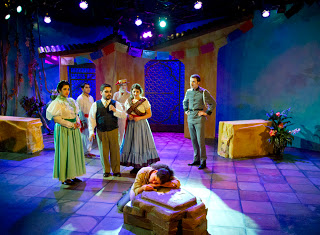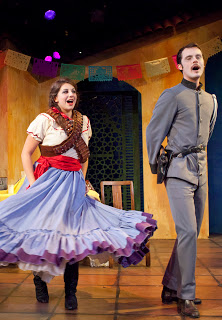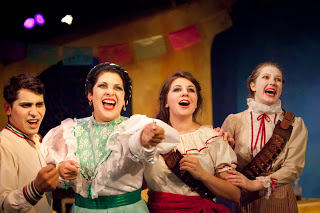 by Carol Wells, The Oregonian
by Carol Wells, The Oregonian
October 22, 2011
A modern-day folk play newly created for Milagro Theatre’s Day of the Dead celebration, “¡Viva la Revolución!” is a cultural event that has the feel of a production one might see in a village square on market day or in the courtyard of a country church.
The story, which seeks to recognize the largely unsung women of the Mexican Revolution, is set mainly in the home of an upper-class family: a mother, father, daughter, her love interest, their American houseguest, and a servant. What makes each of these characters especially noteworthy, however, is that the faces that top their last-century costumes are made up like skulls, complete with bone-white skin and blacked-out eye sockets.
 Poised and gracious, the wife Constanza (Nurys Herrera) provides a good balance for her blustery, no-nonsense husband Ludovico (Enrique E. Andrade). One feels for Ludovico, living-dead or otherwise, because he appears to be isolated in his own household. His daughter (played with humor and spunk by Cristina Cano) is learning to shoot a gun in order to join the revolutionary forces. His servant (the engaging Alberto Romero) is busy planning how to run the hacienda once Ludovico is no longer its master, and his wife is suspiciously familiar with the incendiary writings of Hermila Galindo, a feminist, suffragist and critic of the Catholic church.
Poised and gracious, the wife Constanza (Nurys Herrera) provides a good balance for her blustery, no-nonsense husband Ludovico (Enrique E. Andrade). One feels for Ludovico, living-dead or otherwise, because he appears to be isolated in his own household. His daughter (played with humor and spunk by Cristina Cano) is learning to shoot a gun in order to join the revolutionary forces. His servant (the engaging Alberto Romero) is busy planning how to run the hacienda once Ludovico is no longer its master, and his wife is suspiciously familiar with the incendiary writings of Hermila Galindo, a feminist, suffragist and critic of the Catholic church.
Throughout the run of the play, the Milagro Theatre hosts a display of “ofrendas” in its lobby and in the adjoining community space. These pay tribute to similar altars created in some Mexican homes in celebration of the Day of the Dead. Offered up are incense, candles, food, rosaries, perhaps the favorite alcoholic drink and cigarette of the departed. They are simultaneously respectful and whimsical, somber and colorful.
“¡Viva la Revolución!” is like an ofrenda brought to life in performance. There is respect for the departed, but also plenty of lightheartedness plus bits and pieces of oddness. There are sweet dances (thanks to choreographer Maria Ferrin) and songs, some in keeping with the story, like “La Cucaracha,” which is associated with the revolution. Other songs, like “Sister Suffragette” from the “Mary Poppins” movie, or the 1960s country standard “Green, Green Grass of Home,” are peculiarly placed, though the latter does showcase the pretty voice of Amber Mitchell as Susan, the family’s young American houseguest.
Framing the family’s story is the story of Najwa (Nelda Reyes), which widens the scope of the play’s tribute to include women of all revolutions, especially those occurring today.
Director Olga Sanchez does partly succeed in her intention to have the play celebrate the achievements of revolutionary women, but because of the talent of her cast, particularly the two principals, the play perhaps winds up moving us for an entirely different reason. What makes the most impact is the family struggle: a father who is basically a decent man, but an unquestioning one, trying to absorb the awful fact that his daughter has rejected the values he holds dear. The woman we ultimately most remember is the loving wife, gently nudging her husband toward the realization of the injustice those values represent.
The dialogue is in English and Spanish. For non-native speakers, I would suggest a basic level of proficiency (for example, one year of high-school Spanish) for maximum enjoyment of the production.

